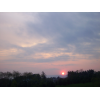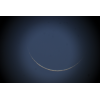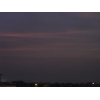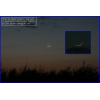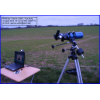Visibility of Jumadal Al-Aula Crescent 1431 AH
- When to Observe Jumadal Al-Aula Waxing (NEW) Crescent ?
- Jumadal Al-Aula Waxing (NEW) Crescent Observation Results
- The OFFICIAL First Day in Different Countries
- When to Observe Rabee' Al-Aakher Waning (OLD) Crescent ?
- Rabee' Al-Aakher Waning (OLD) Crescent Observation Results
When to Observe Jumadal Al-Aula Waxing (NEW) Crescent ?
The geocentric conjunction (Geocentric New Moon) will occur Inshalla on (Wednesday 14 April 2010) at 12:29 UT.
Sighting the new crescent on (Wednesday 14 April 2010) and (Thursday 15 April 2010) is shown in the below graphs using the program Accurate Times by Mohammad Odeh according to Odeh criterion. Where:-
- It is impossible to see the crescent from the areas located under the red color. Because either the Moon on this day sets before the Sunset and/or the topocentric conjunction occurs after the Sunset.
- The crescent is expected to be seen by optical aid only from the areas located under the blue color.
- The crescent is expected to be seen by optical aid from the areas located under the magenta color. In these areas the crescent could be seen by naked eye if the atmospheric conditions are superb and the observer is experienced.
- The crescent is expected to be easily visible by naked eye from the areas located under the green color.
- The crescent cannot be seen from uncolored areas, even though the Moon sets in these locations after the Sunset and the topocentric conjunction occurs before the Sunset, but the Moon is not sufficiently illuminated in order to be seen as crescent even by optical aid.
- Kindly notice that the below graph shows the possibility of seeing the crescent from areas between 60 degrees north of Equator down to 60 degrees south of Equator.
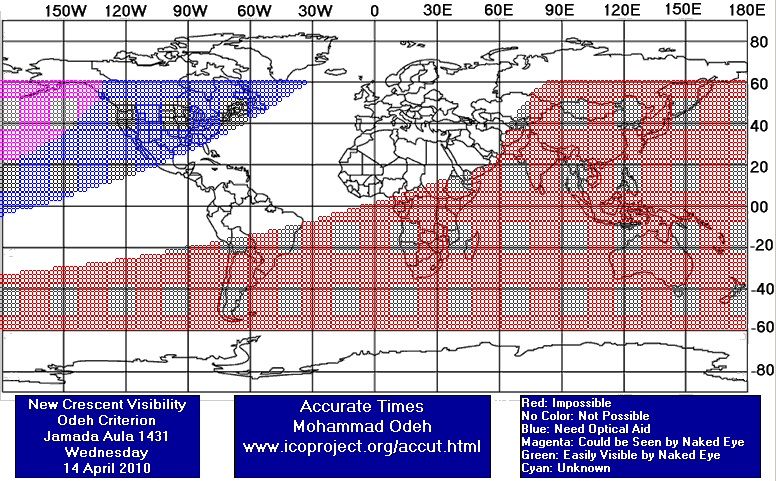

According to the Universal Hejric Calendar (UHC), which is based on the calculated crescent visibility, the start of this month in the Eastern Region will be on Friday 16 April 2010 and in the Western Region will be on Thursday 15 April 2010. Kindly notice that the UHC is a pre-calculated calendar, which adopts a certain criterion to start the new Hejric month. Your country/organization might adopt different criterion to start the new Hejric month. So it is highly advised to read the UHC website before giving any judgment.
- Results of seeing the crescent, and the first day of the month in different countries will be added here Inshalla as we receive the reports from ICOP's members. If you wish to be a member in ICOP, or to know more about it, kindly click here.
Jumadal Al-Aula Waxing (NEW) Crescent Observation Results
Wed 14 April 2010
Algeria
Mr. Hocine Chikh Aissa said: "(5) persons tried to observe the new crescent. It was not seen by naked eyes , member of the club CHIKH AMMI SAID AMATEUR OF ASTRONOMIE. Jupiter and Meurcury were seen by naked eyes. "
Nigeria
Mr. Usman Dukku said: "It was cloudy this evening in Bauchi, Nigeria, therefore we did not organise any sighting trip."
United States
Dr. Javad Torabinejad said: "Using binoculars, we tried sighting the crescent with no success. The sky was very hazy and partly cloudy and soon after we arrived at the sighting location (before sunset), more clouds rolled in and made it impossible to do any sighting. Weather permitting, tomorrow we will try again."
Mr. Jim Stamm said: "Location (WGS 84) = Tucson, Arizona (USA), Longitude = 110.9651 W, Latitude = 32.4206 N, Elevation = 842 meters, Time Zone = -7.0 hours. Surface conditions at location: Temperature = 22 °C, Humidity = 20 %, Pressure = 29.82 in. Banded clouds on the western horizon. Topocentric and local time values from “Accurate Times”: Sunset (at sea level) = 18:58, Moonset (at sea level) = 19:32, Time from new moon at 19:13 = 14 hr. 39 min. Moon lag time = 34 min. Relative Altitude = 6.7 degrees, Elongation from sun = 7.4 degrees, Crescent width = 8 arc seconds, Illumination = 0.4 percent. I was NOT able to see the crescent, even through a telescope. The openings between the cloud bands may have been actually just lighter clouds. Everything was set perfectly. Observer: Jim Stamm, E-mail Address: StammJim@gmail.com"
Thu 15 April 2010
Germany
Eng. Martin Elsaesser said: "Despite clouds and haze the 30h old crescent could be seen with the naked eye. The crescent formed a nice, wide group with the planets venus and merkury, though merkury was only seen with binoculars, due to the haze. The next days might bring a spectacular view of the crescent in colorful evening twilight with the dust from the recent volcano eruption on island."
Nigeria
Mr. Qamarudeen Muhammad said: "We attempted to sight the new Hilal of Jumadal Awwal on the Thursday 15 2010 evening but it was not visible here in Lagos. In a phone chat with Amirul Lajinatul Hilal of Ilorin Kwara State, Nigeria, it was confirmed that they were unable to sight New Hilal. Also in phone chat with Brother Simwal Jubril, he was not able to sight the new Hilal as result of overcast."
Pakistan
Mr. Alam Sultan said: "Not seen by us / easily seen by others. On my request, Today i.e. on Thursday 15 April 2010 (29 Rabee-uth-Thani 1431 in Pakistan) nearly two hundred persons (members of the moon sighting committees of our institute “Jamia-tur-Rasheed” + my friends + their companions) tried to sight the moon at nearly 25 places all over Pakistan and resultantly, Alhamdolillah, moon was seen at 3 places of Balochistan (Solo-Bulaidah, Pishokan & Jiwani) by 35 persons. As it was nearly 8 to 9 degrees hazy in Karachi and many other cities were cloudy or very hazy hence moon was not sighted in those places. Weather was clear at some places but moon was not sighted there also. Note 1: Chairman of central official moon-sighting committee of Pakistan "Mufti Munee-bur-Rahman" told me on my mobile phone that as he also received the positive naked eye sighting from the official meteorological centers of Jiwani and Quetta hence he officially announced that Friday 16 April 2010 is the 1st Jumadal-oola 1431. Note 2: After some days, inshaallah, a detailed report of this observation in Urdu will be available at www.esnips.com/web/moonnewsofjamiaturrasheed "
Saudi Arabia
Mr. Saleh Al-Saab said: "The crescent is NOT seen on the previous day (14th)"
Senegal
Mr. Ibrahima Lo said: "For the national committee of Hilal Sighting, Saturday 17 april will be 1 Jumadal awwal 1431."
South Africa
Dr. Abdurrazak Ebrahim said: "We have now experienced 5 consecutive lunar months of 30 days each"
Tanzania
Mr. Zaffar Sheriff said: "Thick clouds sat on the horizon, which did not allow us to see the sun set into the horizon. Heavy haze, and scattered clouds over the western horizon prevented the 26hr plus crescent to be observed. Elongation at 13.4 and altitude 7.8 with duration of 37minutes."
United Kingdom
Eng. Qamar Uddin said: "On Thursday 15 April 2010 (29 Rabi-ul Thani 1431 AH) many people from throughout UK have attempted to sight the youngest crescent moon (Hilal) of Jumada Al-Awwal after sunset. Most places were overcast, but a few places were able to sight the 31 hours old Hilal between patchy clouds, starting from York Gliding Centre (Rufforth) at 21:00 hrs BST by naked eye and binoculars. The Hilal was also live webcasted from York to the Internet. Therefore, the Ulama have decided that the month of Rabi-ul Thani 1431 AH will have 29 days and the month of Jumada Al-Awwal (or Jumada Al-Ula) 1431 AH will start from Friday 16 April 2010, Insha-Allah. May Allah rewards all those who have tried to revive the Sunnah of moon sighting, this month. The York (North Yorkshire) group of 15 observers comprised of the following people. From Batley: Maulana Hasib Mayet, Maulana Imran Lunat, Ismail Bhai Lunat and Vashiullah Ibn Bodiyat. From York: Moin Uddin and Qamar Uddin (also Shaykh Zubair Ahamad and Kurshid Anwar from Mosque). Members of York Astronomical Society included: Martin Whipp, Martin Dawson, Philip Holmes, Glen Berry, Martin Hall, Phil Holmes, John Rowlands and Andrew Lawson. From High Wycombe: Maulana Amir Aziz plus 7 others. From South London: Ayyub Kara. From Bangor (North Wales): Dr Ayad A. Mawla. Note: We were not expecting to sight the Hilal in York due to the weather forecast being cloudy and the Icelandic volcanic dust on the UK horizon, hence our webcast was not publicised (or well prepared either!)."
United States
Dr. Javad Torabinejad said: "This evening, we sighted the crescent moon of Jumada-1 in Blacksburg, VA, first by using binoculars (7X50 and 10X50) and then by naked eye. I arrived at the sighting location before sunset and left before moonset (moonset: 9:32 pm EDT). The first binocular sighting was at 7:54 pm followed by the naked eye sighting at 7:58 pm. The horns were at 4:30 and 7:00 O'clock (4:30;6:00;7:00). At 8:00 pm, the temperature, dew point, relative humidity, and pressure were 69.8 F, 44.6 F, 40%, and 30.28 in, respectively. The sky was hazy with a few lower clouds close to the western horizon."
The OFFICIAL First Day in Different Countries
Thu 15 April 2010
1 . Indonesia
2 . Nigeria
3 . Saudi Arabia
Fri 16 April 2010
1 . Pakistan
2 . United Kingdom
3 . United States
Sat 17 April 2010
1 . Senegal
2 . South Africa
When to Observe Rabee' Al-Aakher Waning (OLD) Crescent ?
The geocentric conjunction (Geocentric New Moon) will occur Inshalla on (Wednesday 14 April 2010) at 12:29 UT.
Sighting the OLD crescent on (Wednesday 14 April 2010) and on (Tuesday 13 April 2010) is shown in the below graphs using the program Accurate Times by Mohammad Odeh according to Odeh criterion. Where:-
- It is impossible to see the OLD crescent from the areas located under the red color. Because either the Moon on this day rises after the Sunrise and/or the topocentric conjunction occurs before the Sunrise.
- The crescent is expected to be seen by optical aid only from the areas located under the blue color.
- The crescent is expected to be seen by optical aid from the areas located under the magenta color.. In these areas the crescent could be seen by naked eye if the atmospheric conditions are superb and the observer is experienced.
- The crescent is expected to be easily visible by naked eye from the areas located under the green color.
- The crescent cannot be seen from uncolored areas, even though the Moon rises in these locations before the Sunrise and the topocentric conjunction occurs after the Sunrise, but the Moon is not sufficiently illuminated in order to be seen as crescent even by optical aid.
- Kindly notice that the below graph shows the possibility of seeing the crescent from areas between 60 degrees north of Equator down to 60 degrees south of Equator.
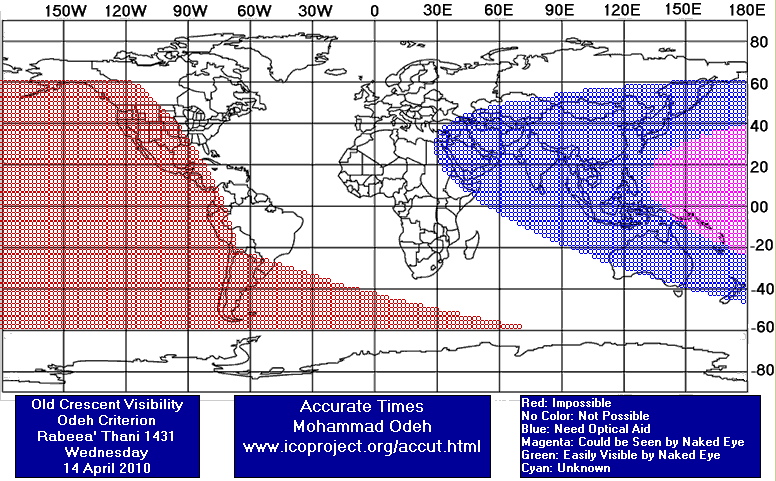

Rabee' Al-Aakher Waning (OLD) Crescent Observation Results
Tue 13 April 2010
United States
Mr. Jim Stamm said: "Observed: Tuesday; April 13, 2010 - 05:56 (Local) Location (WGS 84) = Tucson, Arizona (USA) Longitude = 110.9651 W Latitude = 32.4206 N Elevation = 842 meters Time Zone = -7.0 hours Surface conditions at location: Temperature = 9 °C Humidity = 66 % Pressure = 29.80 in. Only slight haze kept the sky from being very clear. Magnitude limit at 8.5 degrees altitude with 120 power in C-8 telescope, before onset of twilight = 11.3 Topocentric and local time values from “Accurate Times”: Moonrise (at sea level) = 05:04 Sunrise (at sea level) = 05:52 Time from new moon at 05:56 = 22 hr. 38 min. Moon lag time = 48 min. Relative Altitude = 9.7 degrees Elongation from sun = 11.7 degrees Crescent width = 19 arc seconds Illumination = 1.0 percent Crescent first observed through 8” SC telescope: Time = 05:56 Moon Altitude = 08.5 degrees Final observation with telescope: Time = 06:06 Moon Altitude = 10.8 degrees What a surprise! I was expecting to maybe see the crescent by naked eye, certainly through the finder, but neither. I barely saw it through the 8 inch. I had to tap the scope to confirm that I had the crescent. I watched it on and off for 10 minutes, tapping to enhance the image. I finally lost it while playing with the focus. Observer: Jim Stamm E-mail Address: StammJim@gmail.com"
Wed 14 April 2010
United Kingdom
Eng. Qamar Uddin said: "The eastern horizon before sunrise was cloudy today and yesterday. The waning crescent of Rabi-ul Thani 1431 AH was not seen from York (UK)."
